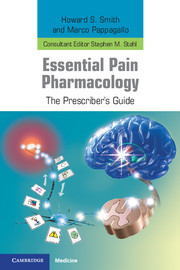Description
Essential Pain Pharmacology
The Prescriber's Guide
Authors: Smith Howard S., Pappagallo Marco
State-of-the-art, clear, concise presentation of a wide array of analgesic agents, with practical pearls to aid prescribing.
Language: English
Subject for Essential Pain Pharmacology:
Approximative price 90.79 €
In Print (Delivery period: 14 days).
Add to cart
Publication date: 09-2012
575 p. · 15.3x22.7 cm · Paperback
575 p. · 15.3x22.7 cm · Paperback
Description
/li>Contents
/li>Biography
/li>
Essential Pain Pharmacology: The Prescriber's Guide expertly reviews the most important medications used to relieve pain, now considered by many physicians as the fifth vital sign. The catalogue of analgesics has expanded rapidly, and this text presents the most up-to-date, comprehensive array of agents available for prescribing. Each clear and concise drug entry covers the range of indications, advantages and disadvantages, and tips for appropriate dosing and avoiding adverse effects. A separate section covers nutraceuticals, a class of drug increasingly used to manage chronic pain, yet little discussed in medical literature. The detailed description of each medication enables the user to make quick and informed decisions, confident that they are best serving the needs of their patients. Practical 'pearls' for each entry provide a quick go-to reference for the key information to consider before prescribing. This concise user-friendly reference is a must-have on the shelf of every physician.
Introduction; List of icons; Acetaminophen/Paracetamol; Almotriptan; Amitriptyline; Aspirin; Baclofen; Botox-A; Botox-B; Buprenorphine; Butorphanol; Carbamazepine; Carisoprodol; Celecoxib; Choline magnesium trisalicylate; Citalopram; Clomipramine; Clonazepam; Clonidine; Codeine; Cyclobenzaprine; Cyproheptadine; Dantrolene; Desipramine; Desvenlafaxine; Diazepam; Diclofenac; Diflunisal; Dihydroergotamine; DM; Doxepin; Dronabinol; Duloxetine; Eletriptan; Escitalopram; Etodolac; Fenoprofen; Fentanyl; Flunarizine; Fluoxetine; Flurbiprofen; Fluvoxamine; Frovatriptan; Gabapentin; Hydrocodone; Hydromorphone; Ibuprofen; Imipramine; Indomethacin; IT ziconotide, epidural clonidine; Ketamine; Ketoprofen; Ketorolac; Lacosamide; Lamotrigine; Levetiracetam; Levorphanol; Lidocaine 5%; Maprotiline; Meclofenamate; Mefenamic acid; Meloxicam; Memantine; Meperidine/Pethidine; Metaxalone; Methadone; Methocarbamol; Methylphenidate; Mexiletine; Milnacipran; Modafanil; Morphine; Nabumetone; Nalbuphine; Naproxen and naproxen sodium; Naratriptan; Nortriptyline; Orphenadrine; Oxaprozin; Oxcarbazepine; Oxycodone; Oxymorphone; Pamidronate; Paroxetine; Pentazocine; Piroxicam; Pizotifen; Pregabalin; Propranolol; Rizatriptan; Salsalate; Sertraline; Sulindac; Sumatriptan; Tapentadol; Tiagabine; Timolol; Tizanidine; Tolmetin; Topiramate; Tramadol; Valproic acid and Divalproex; Venlafaxine; Verapamil; Zolmitriptan; Zonisamide; Nutraceuticals and medical food preparations for chronic pain: Acetyl-L-carnitine; Alpha lipoic acid; Bromelain; Capsaicin 8%; Coenzyme Q11; Magnesium; Metanx; NAC; Omega-4; PEA; Riboflavin; Vitamin D; Index by drug name; Index by use; Index by class; Abbreviations.
Howard S. Smith is Professor of Anesthesiology, Internal Medicine, Physical Medicine and Rehabilitation and Academic Director of Pain Management, Albany Medical College, Albany, NY, USA.
Marco Pappagallo is Director, Pain Management and Medical Mentoring, New York Medical Home for Chronic Pain, New York, NY, USA; Director, Medical Intelligence, Grünenthal, Aachen, Germany and Professor of Medical Biotechnology Sciences, University of Rome, Italy.
Marco Pappagallo is Director, Pain Management and Medical Mentoring, New York Medical Home for Chronic Pain, New York, NY, USA; Director, Medical Intelligence, Grünenthal, Aachen, Germany and Professor of Medical Biotechnology Sciences, University of Rome, Italy.
© 2024 LAVOISIER S.A.S.

